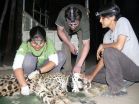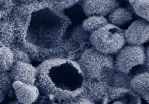(Press-News.org) Scientists have identified four new genes associated with the severe food allergy eosinophilic esophagitis (EoE). Because the genes appear to have roles in other allergic diseases and in inflammation, the findings may point toward potential new treatments for EoE.
"This research adds to the evidence that genetic factors play key roles in EoE, and broadens our knowledge of biological networks that may offer attractive targets for therapy," said study leader Hakon Hakonarson, M.D., Ph.D., director of the Center for Applied Genomics at The Children's Hospital of Philadelphia (CHOP).
Hakonarson and colleagues from other hospitals and academic centers published the study online Nov. 19 in Nature Communications. The research builds on a 2010 study by Hakonarson and colleagues that identified TSLP as the first major gene associated with EoE.
Only recently recognized as a distinct condition, EoE has been rapidly increasing in prevalence over the past 20 years. Its hallmark is inflammation and painful swelling in the esophagus, along with high levels of immune cells called eosinophils. It can affect people of any age, but is more common among young men who have a history of other allergic diseases such as asthma and eczema.
EoE is often first discovered in children with feeding difficulties and failure to thrive. Because children with EoE are often allergic to many foods, they may be placed on a highly restricted diet containing no large food proteins, to allow time for their symptoms to resolve. Physicians then perform tests to determine which foods a child can or cannot eat.
In the current research, the investigators performed a genome-wide association study (GWAS), first in a discovery cohort of 603 EoE patients compared to 3,637 control subjects, then in a replication cohort of 333 patients versus 675 controls. All the subjects were of European ancestry.
The study team identified four novel- loci significantly associated with EoE. Two of them, STAT6 and c11orf30, previously were found in association with both allergies and autoimmune diseases. Two other gene loci, ANKRD27 and CAPN14, were specific to EoE.
CAPN14 may be of particular interest, said co-author Jonathan Spergel, M.D., Ph.D., a pediatric allergist-immunologist at CHOP. The gene appears to be expressed only in the esophagus. "A recent study in a mouse model for asthma showed that a drug that inhibits a related protein reduces inflammation and improves airway functioning in animals," he said. While a similar drug might relieve esophageal inflammation in children with EoE, he added, "However, the finding of four genes indicates that a single drug might not work for all patients with EoE, and we may need a tailored approach to treatment, based on patients' genetic profiles."
Spergel was a co-author with Hakonarson on the 2010 study that identified the first EoE-associated gene. He directs CHOP's Center for Pediatric Eosinophilic Disorders, one of the nation's premier programs for such diseases. The CHOP center recently joined a new NIH-funded network, the Consortium of Eosinophilic Gastrointestinal Disease Researchers, which brings together leading centers in the field.
Patrick M.A. Sleiman, Ph.D., of the Center for Applied Genomics at CHOP, was the first author of the current paper, and performed the data analysis. Sleiman, Hakonarson and Spergel are also on the faculty of the Perelman School of Medicine at the University of Pennsylvania. Other co-authors were from the University of California, San Diego and Rady Children's Hospital; Northwestern University; Stanford University School of Medicine and Lucile Packard Children's Hospital; Academic Medical Center, Amsterdam, the Netherlands; and Children's Hospital Colorado and the University of Colorado School of Medicine.
INFORMATION:
Funders of this study included the U.S. Department of Defense (award A-16809.2), the National Institutes of Health (grants HG006830, DK100303, AI092135), Food Phight Fund for Eosinophilic Esophagitis and a gift to the Center for Applied Genomics from the Adele S. and Daniel S. Kubert Estate.
"GWAS identifies four novel eosinophilic esophagitis loci," Nature Communications, published online Nov. 19, 2014.
About The Children's Hospital of Philadelphia: The Children's Hospital of Philadelphia was founded in 1855 as the nation's first pediatric hospital. Through its long-standing commitment to providing exceptional patient care, training new generations of pediatric healthcare professionals and pioneering major research initiatives, Children's Hospital has fostered many discoveries that have benefited children worldwide. Its pediatric research program is among the largest in the country. In addition, its unique family-centered care and public service programs have brought the 535-bed hospital recognition as a leading advocate for children and adolescents. For more information, visit http://www.chop.edu.
Study says leopards stay surprisingly close to homes
Leopard home range around humans can be comparable to world's best protected areas
Article available from PLOS ONE
NEW YORK (November 21, 2014) - In the first-ever GPS-based study of leopards in India, led by WCS and partners has delved into the secret lives of these big cats, and recorded their strategies to thrive in human-dominated areas.
The study concludes that leopards in human areas are not always 'stray' or 'conflict' animals but residents, potentially requiring policy makers to rethink India's leopard-management ...
November 21, 2014 -- A study conducted by researchers at Columbia University's Mailman School of Public Health shows that obesity costs the U.S. $8.65 billion per year as a result of absenteeism in the workplace --more than 9% of all absenteeism costs. The consequences of obesity among the working population go beyond healthcare and create a financial challenge not only for the nation but for individual states as well. Findings are published online in the Journal of Occupational and Environmental Medicine.
The study is the first to provide state-level estimates of obesity-attributable ...
Lugano/Geneva, Switzerland, 21 November 2014 - New evidence that immune checkpoint inhibitors may work in glioblastoma and brain metastases was presented today by Dr Anna Sophie Berghoff at the ESMO Symposium on Immuno-Oncology 2014 in Geneva, Switzerland.
The novel research shows that brain metastases have dense concentrations of tumour infiltrating lymphocytes, providing an immunoactive environment. Moreover, both primary and secondary brain cancers often exhibit high expression of the immunosuppressive factor programmed cell death ligand 1 (PDL1), which can be inhibited ...
One of the most mysterious forms of life may turn out to be a rich and untapped source of antibacterial drugs.
The mysterious life form is Archaea, a family of single-celled organisms that thrive in environments like boiling hydrothermal pools and smoking deep sea vents which are too extreme for most other species to survive.
"It is the first discovery of a functional antibacterial gene in Archaea," said Seth Bordenstein, the associate professor of biological sciences at Vanderbilt University who directed the study, "You can't overstate the significance of the antibiotic ...
Prison policies vary on treating transgendered inmates, which could put inmates and institutions at risk. Gina Gibbs, a University of Cincinnati criminal justice doctoral student, will present a synopsis of the legal issues posed by such inmates at the annual meeting of the American Society of Criminology. The national conference runs from Nov. 19-22 in San Francisco.
At the center of the debate are Eighth Amendment protections against cruel and unusual punishment, widely varying policies on the treatment of transgendered populations and, Gibbs says, court crackdowns ...
CHAMPAIGN, Ill. -- Retired baseball stars Barry Bonds, Mark McGwire and Rafael Palmeiro each had Hall of Fame-worthy numbers, each hitting more than 500 home runs.
All three also were tarred by allegations of steroid use.
Their stories, however, received very different treatment over 12 years of national television news coverage, says University of Illinois professor Brian Quick, lead author on a paper about that coverage and its effects, published online Nov. 20 by the journal Communication Research.
"We found that Bonds received more than twice as many negative stories ...
This news release is available in German. One lesson that policymakers and financial regulators have drawn from the financial market crisis is that banks need to be backed by more equity. But banks have found it hard to increase their core capital positions - in other words, the equity available to them long-term. Since 2009, this has led European banks to increasingly deploy an instrument that allows them to convert debt into equity in times of need: contingent convertible bonds, also known as CoCo bonds. Banks issue these bonds at fixed interest rates - as is normal ...
Gases don't conduct heat as well as solids do. Cellular or aerated concretes take advantage of this effect, which experts call "gas-phase insulation". The heat barrier is achieved by air encased in the cavities of the concrete. But gas-phase insulation has far greater potential than keeping our homes warm. It can also be used to protect turbine engine and waste incinerator components when subjected to intense heat. All you need to do is transfer this effect to a coating that is just a few hundred micrometers thick.
Temperature differences of over 400 degrees Celsius
Scientists ...
The fixed combination of canagliflozin with metformin (trade name: Vokanamet) has been approved since April 2014 for adults with type 2 diabetes mellitus in whom diet and exercise do not provide adequate glycaemic control. The German Institute for Quality and Efficiency in Health Care (IQWiG) now examined in a dossier assessment whether the new drug combination offers an added benefit over the appropriate comparator therapy. No such added benefit can be derived from the dossier, however, because the manufacturer did not present any suitable data for any of the possible ...
Lugano/Geneva, Switzerland, 21 November 2014 - The possibilities for personalised vaccines in all types of cancer are revealed today in a lecture from Dr Harpreet Singh at the ESMO Symposium on Immuno-Oncology 2014 in Geneva, Switzerland.
"One of the biggest hurdles in cancer immunotherapy is the discovery of appropriate cancer targets that can be recognised by T-cells," said Singh, who is scientific coordinator of the EU-funded GAPVAC phase I trial which is testing personalised vaccines in glioblastoma, the most common and aggressive brain cancer. "In the GAPVAC trial ...






